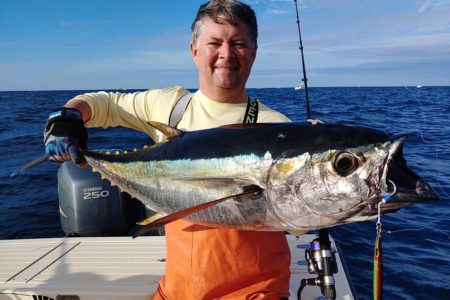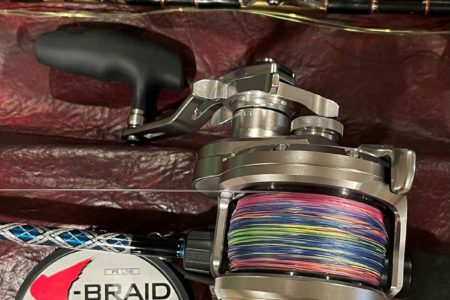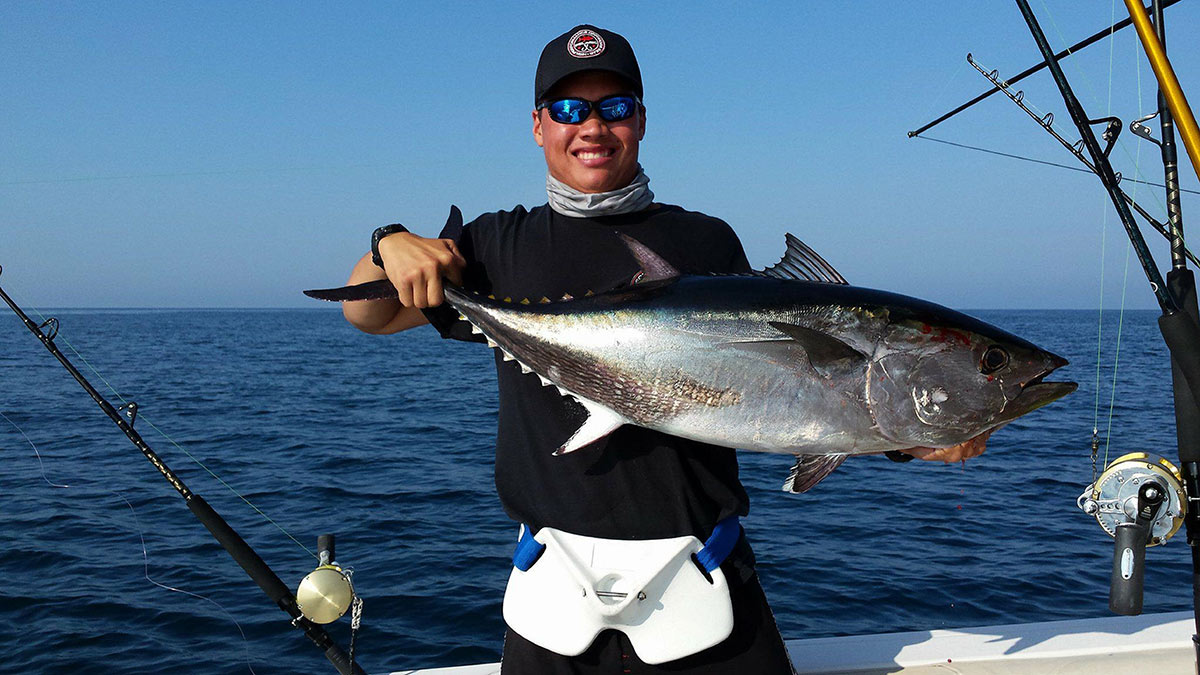
Tried and true trolling spread techniques that tuna and mahi love.
When it comes to trolling for midrange pelagics – usually bluefin, yellowfin, mahi, and maybe the occasional billfish – there are many options for lure choice and lure placement. It can easily become overwhelming, but with some careful, yet simple thought, all the bases can be covered with just a few lines.
When it comes to offshore fishing, it is possible for almost anything to wander into the spread. The worst thing that could happen is that the fish overpowers the rods and reels, ultimately causing a break-off or spooling the reel. For trolling the inshore and mid-shore grounds, I prefer 30w and 50w reels (with the 50w being used for way back or long baits). Smaller reels like 20 and 25 size reels will also work, as long as there is enough line capacity and the drag is properly set.
A main line of 40- to 60-pound on the smaller 20/30w reels is sufficient, and 80-pound is fine on the 50w reels. This may seem like heavy main line, but it is especially helpful for when the fish is almost boat-side and being leadered, which is when there is most pressure on the line/leader.
Now that the rods and reels are situated, the lures are what is going to hook the fish. And since there is no way to tell what the fish will favor on a particular day, it is good to have an assortment of lures to match any conditions that may arise. Having a few spreader bars, daisy chains, single lures (like cedar plugs, green machines, etc.) and ballyhoo rigs/skirts – all in various colors such as rainbow, pink, green, and black/purple – is essential to capitalizing on what the fish are feeding on that day.
Preventing beak-offs by constantly checking the main lines and leaders for chafes, nicks and abrasions is very important to make sure the chances of boating the fish are as high as possible. Making sure the hooks are sharp (as well as taking the hook protectors off) and that the swivels are secure/closed is also a commonly overlooked, yet very important step. Make sure to have all the necessary landing gear as well; gaffs, tail ropes, leader gloves and fighting belts are all very important to have on board!
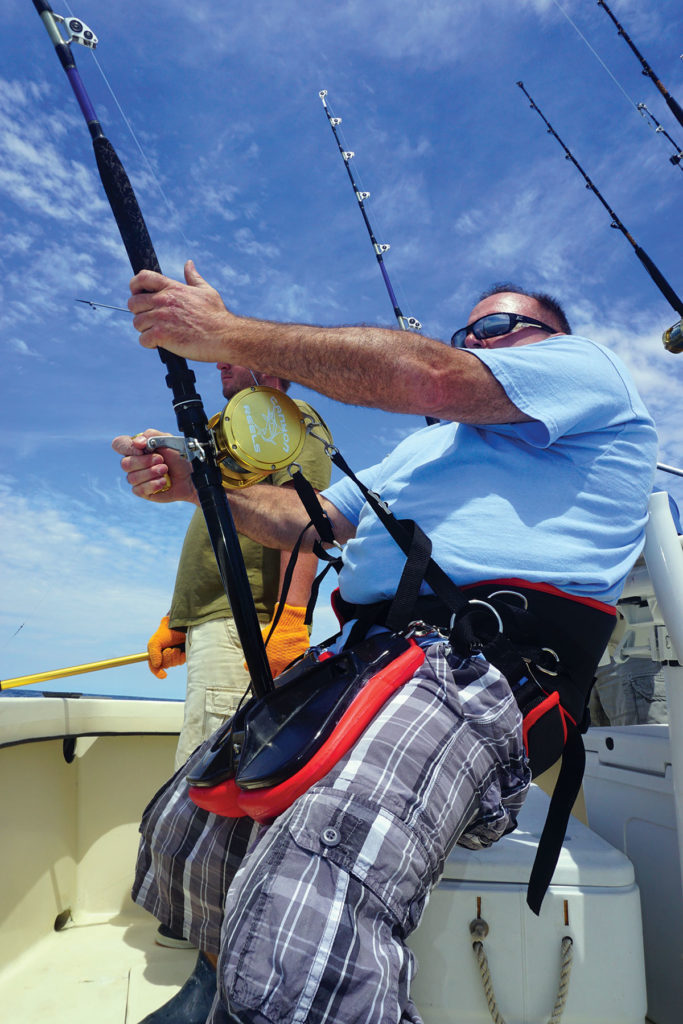
Who’s in Your Corner?
Each boat has a port and starboard corner. Usually, the lines trolled from these corners are in flat line clips, which are release clips that decrease the angle at which the lure is introduced to the water. This lure is usually fished relatively close to the transom between the third and fifth wake. One of the most popular and productive lures that can be fished here is a cedar plug. This is a simple, cigar shaped piece of wood (cedar of course), with a lead head and a hook out the back. It swims erratically like a wounded baitfish and matches the profile. Splash bars and daisy chains are popular options as well. If splash bars are used, it is preferred that smaller size squids are used, usually in the 4.5- to 6-inch range. I have personally found this size successful, especially in green or pink. The pink also acts as an excellent lure for any mahi that may be in the area!
Ballyhoo are also excellent lures to troll from the corners on flat line clips. I prefer fishing them on a 3-ounce or even a 5-3/4-ounce head. I find that these sizes hold the lure underneath the white-water created by the engines and gives it a clean presentation. One commonly overlooked lure that many would consider a classic for the flat line clip is the versatile Clarkspoon—a flashy, simple and effective lure that matches the profile of many different baitfish. These lures are usually fished with a 4- to 8-ounce drail about 6 feet ahead of the lure. Clarkspoons have proven to be deadly for tuna, mahi, bonito and many other fish that may wander into the spread!
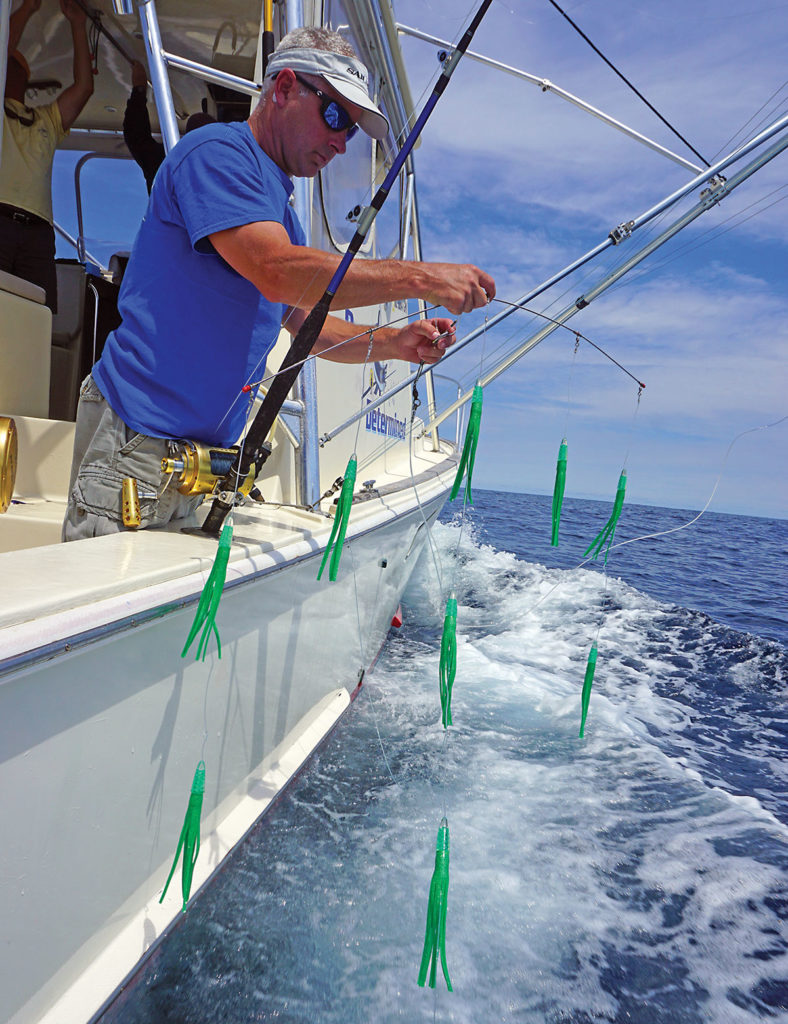
In With the Outriggers
Outriggers will increase the width of your spread by anywhere from 30 to 50 feet depending on the length of the outrigger poles themselves. They have become vital to tuna fishing and are one of the most productive components in a tuna spread. They bring the lures out to the sides of the spread by using pulleys and release clips. Almost all styles of lures can be trolled off the outriggers. However, the most popular in my opinion are spreader bars, daisy chains and ballyhoo. Spreader bars and daisy chains have a large profile and presence in the water due to their multiple teasers/baits on the rig. These make a lot of commotion in the water and attract fish! The outriggers bring the lures far enough out to the sides to where they are not directly in the boat wake and the water is somewhat flat. This helps the splash lures stand out from the rest of the lures in close to the boat. Sterling Tackle has also developed a “wide tracker” bar, which has an angled keel on it and tracks anywhere from 25 to 50 feet out to the side, which gets them in the clean, no-wake/flat water. These bars coupled with the outriggers have proven to be deadly because of how far out from the boat they are.
Ballyhoo are also very effective when trolled off the outriggers – they’re effective everywhere in the spread. However, they are popular on the outriggers, especially on the “long” rigger, which is when the lure is let out over 75 to 90 yards back. The outriggers bring the ballyhoo out to the side, and when the lure is that far back, it is in clean water and is more isolated from the rest of the spread and commotion which helps it stand out. Anything from weightless ballyhoo to 6-ounce heads work well.
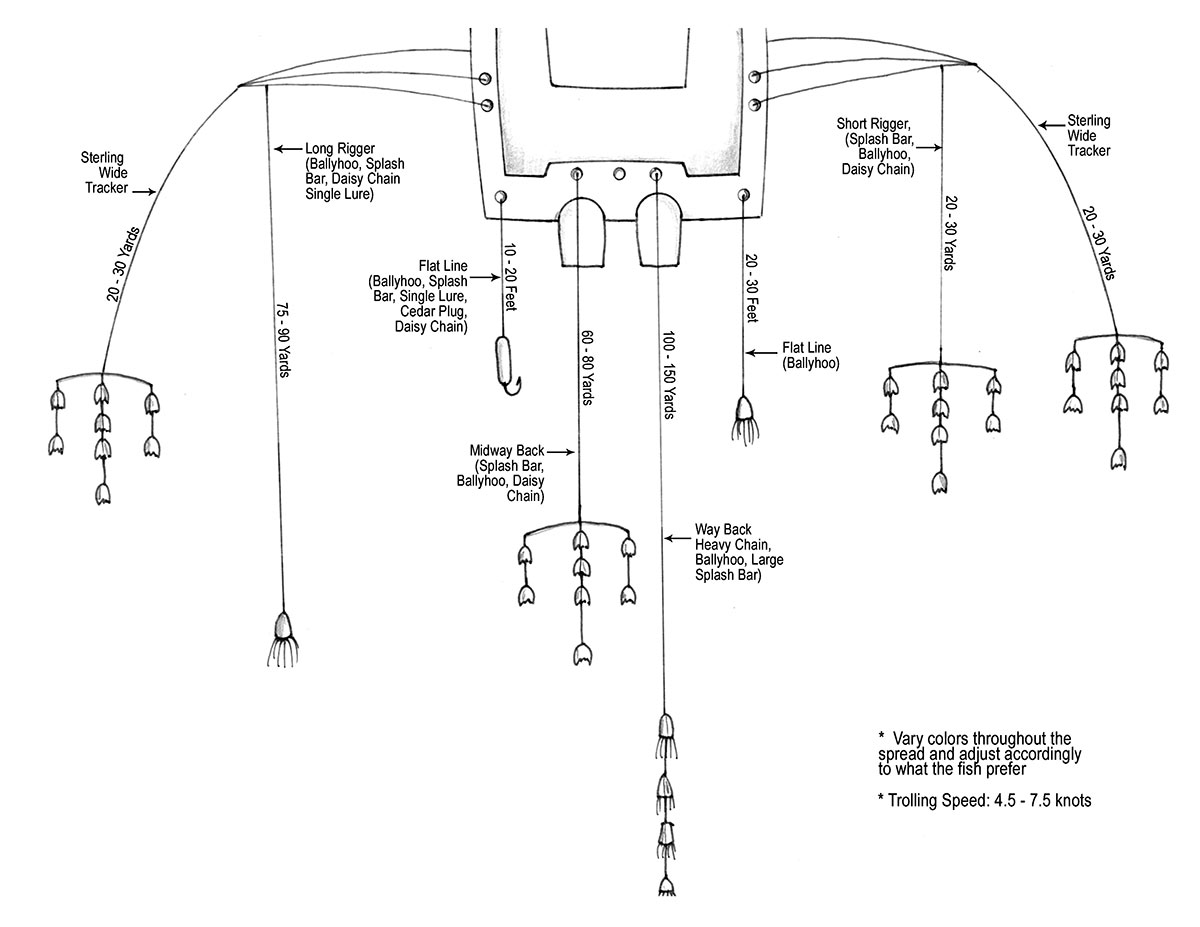
Riding Shotgun
When lures are trolled in the shotgun position in the spread, it means they are being trolled directly off the rod tip with no release clips or riggers. These shotgun lures are usually heavy lures, way back, or a combination of both. Most boats troll one or two of these shotgun lures, usually one way back and one mid-way back. One of these lures (usually the way back) can be trolled off a center rigger as long as it can handle the drag of the lure.
The way back lure can really be anything from a spreader bar, daisy chains, ballyhoo, etc. However, the most popular way back lure is a ballyhoo (usually on a 3- to 8-ounce head/skirt) or a larger 36- to 42-inch splash bar. One type of lure that is also very effective way back is a heavy chain. Sterling Tackle makes heavy Joe Shute chains that get down fairly deep and could get the bait in the strike zone when the fish are a little bit deeper. Sterling also makes a Deep Runner chain, which is very heavy and gets even deeper in the water column.
On slow days, I have found that the way back usually is the only lure to get bit by tuna, especially bluefin. The way back lures should be trolled anywhere from 100 to 200 yards back on at least 50-pound-class tackle. The mid-way back lure can also be any lure in the arsenal. There really aren’t any wrong choices; much like the way back, popular selections include spreader bars, daisy chains and ballyhoo. For this particular spot in the spread, I usually opt for a splash bar. I like to see either the way back or mid-way back lure to be sure they don’t tangle and I prefer the ballyhoo or Shute chain to be way back.
Color Selection
Color selection is an important part to offshore fishing. With clear and clean water, the colors really stand out, and the fish can get a better look at the lures. There are plenty of color options, but when it comes right down to it, the reliable standby colors such as rainbow, black and purple, pink, and of course green or zucchini are always great choices. Blue and white, crystal, and white are also popular colors that have proven to be productive.
Pink and rainbow are great to have out because the mahi seem to always hit those colors. Black and purple I find to be especially effective on low-light or cloudy days, but there have been plenty of clear days when the tuna wouldn’t touch anything except black and purple. Blue and white along with crystal I find particularly hot when it comes to ballyhoo skirt options. There’s just something about those colors over a bally that drives those tuna crazy!
Quite frankly, tuna will hit any of these colors, it just depends what they are favoring that day. It’s really all a matter of starting the day with one or two of each color in the spread and adjusting accordingly depending on what the fish are biting. There are endless ways to pull lures in the spread that could be the difference between putting a fish in the box or going home empty-handed. Being able to adapt to the conditions, read the fish’s behavior, and capitalize on the opportunities is what makes a good fisherman, great. Don’t be afraid to change up the spread if the fish aren’t interested; you never know what may work on a particular day.


